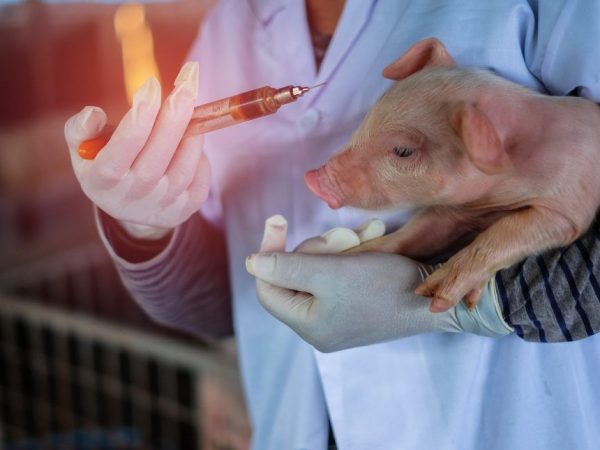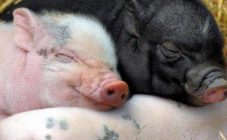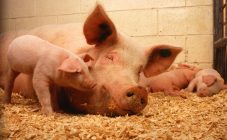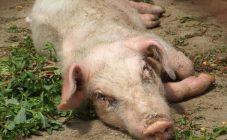Content:
Pig farming is a pretty lucrative business. If piglets and adults are not vaccinated in a timely manner, significant losses can be incurred. Vaccination is one of the must-haves in pig care.
Pets are susceptible to many diseases. Therefore, pigs are vaccinated as early as possible. In addition to the obligatory injections, vitamin complexes are introduced into the diet. Iron is especially important for piglets.
Piglet vaccinations
There is a standard approved plan that tries to vaccinate pigs. But it is only required for industrial animal breeding. At home, vaccinations for piglets are selected, taking into account the peculiarities of their development and living conditions.
Vaccination of newborns
| Term from birth, days | Vaccine name | From what | How the injection is given |
| 3 | Ferranimal (Ferraglucan) | Piglets need iron to avoid anemia * | · "Iron" solution with a volume of 2 ml is injected behind the ear; The procedure is repeated for 3 days, making an injection in the morning |
| 8 | Dectomax (Panakur, Ivermek, etc.) | Worm is dangerous for piglets and affects weight loss | Re-vaccinate against worms after 11 months using the same drug |
| 10 | Products containing calcium and potassium | Without this treatment, there is a risk of developing rickets ** | One-time vaccination, intramuscular |
| 20 | Vaccine based on Salmonella typhimurium and Salmonella choleraesuis (Suigard) | Essential for the prevention of salmonellosis | The injection is done subcutaneously, twice with an interval of 10 days |
| PPD | Vaccine against salmonellosis, pasteurellosis and enterococcal infection in piglets | When using the ppd vaccine for pigs, instructions are required. It clearly states the periods of drug administration. For piglets, the PPD vaccine is administered strictly 4 g each twice with an interval of 6 days | |
| THX | This drug must be vaccinated 3 times according to the following scheme: · The first 2 injections are given with an interval of 8 days; 3rd - 30 days after the 2nd vaccination | ||
| 21 | SUIMUN KChS LK-M (or VNIIViM) | Plague is the most dangerous disease of pigs. The last outbreak of the epidemic captured Stavropol 2 years ago | The powder is diluted only with saline (water cannot be used); Revaccination is performed after 45 days |
* If anemia is detected, solutions of ferrous sulfate (15 g) and copper (5 g) are introduced into the daily diet of piglets (preferably in water) for 20 days.
** Additionally, fish oil, chalk or limestone, shells, and Tetravit vitamins are added to the feed. It is recommended to quartz the pigsty every other day for 2 weeks.
This concludes the mandatory list of vaccines for small pigs. Some farmers work with a veterinarian to decide what other vaccinations to give their piglets and when.
For those who do not know how to give an injection to a pig, it is better to seek help from a veterinarian.
How the injection is given
The right approach is needed in vaccination - not all vaccinations are given intramuscularly:
- the simplest are subcutaneous;
- the injection can be intrathoracic or peritoneal;
- some drugs are given intra-aortic;
- medicines are often dripped onto the mucous membrane of the eyes.
The farmer can only give intramuscular and subcutaneous injections on his own. The use of ophthalmic preparations is allowed if the correct dosage is maintained. In all other cases, it is better to trust a professional.
Basic injection rules:
- for newborn piglets, subcutaneous injections are best done behind the ear; for this, the triangle of the skin fold is pulled back with the auxiliary hand and the needle is carefully inserted;
- the inner thigh is great for injections - the fiber is well developed here;
- the hind leg (or rather its upper part) is a suitable place for intramuscular injections; the main rule here is the perpendicular position of the needle relative to the body; the movement of the hand at the moment of the injection should be sharp.
To give an injection to a little pig, you need skill, so you can't do without a partner here - he will help to rule the position of the animal.
Adults very quickly get used to the procedure and are calmer. It is enough to scratch the pig behind the ear, so that it lies down and substitutes the right place.
Vaccination of older individuals
When the pig is one month old, the injection period does not end. Drugs for other diseases continue to be vaccinated.
Vaccination of young animals and adults
| Term from birth, days | Vaccine name | From what | How the injection is given |
| 45 | VGNKI | Leptospirosis is dangerous as it is transmitted by airborne droplets | If a revaccination is not done after a week, the vaccination will not give an effect |
| 60-70 | SUIMUN ERI (Lyophysilate) | Erysipelas is a skin disease that causes a lot of inconvenience | Vaccinations are placed behind the ear. Dilute the powder with saline. One dose is 1 mg * |
| 70-90 (100) | Immunolactan | Vaccination will save you from deadly foot and mouth disease | Up to 3 months of age, the manual injects piglets with 0.4 mg of the drug. In the older period - already 0.1 mg ** |
* Not all farmers know how many times they give pigs an erysipelas shot. The drug is injected again one month after vaccination. Another revaccination is done 5 months after the second procedure.
** If a sucker gets sick with foot and mouth disease, then a fatal outcome is inevitable, because newborns are not given this vaccine.
Vaccination of sows
The sow also needs vaccination. Such immunization is useful not only for the pig, the future piglets already in utero receive some of the drugs that make the birth not such a dangerous moment.
For piggy producers, vaccination begins even before pregnancy and includes the following stages:
- 5 months before insemination, an injection of erysipelas is given;
- 12 and 6 months before mating, deworming is carried out;
- Once a year, use the plague vaccine;
- 1.5 weeks before conception, Ivermek is placed (against parasites and skin diseases);
- for 7 days they take iron for pigs.
A pregnant pig is vaccinated 1.5 months before farrowing from salmonella. This vaccine is re-administered after 10 days. 30 days before the appearance of the babies, the injection of Ivermek is repeated and vaccinated against erysipelas.
Piglet care
Despite the fact that the body of little pigs received part of the vaccines in the womb, newborns are still susceptible to various infections. In order to preserve the livestock, other methods of care are also used for babies, in addition to vaccinations:
- maximum hygiene must be observed in the pigsty;
- maintain optimal humidity, temperature regime - 22-25 degrees;
- debug the ventilation system.
With small signs of infection, the diseased pig is moved to a separate pen. At the same time, standard vaccinations for piglets against erysipelas and other diseases are not used for an infected baby. This requires a special serum, the use of which is mandatory with the introduction of antibiotics.
Preventive measures
Not only vaccinations will help to avoid diseases, but also a number of preventive measures: disinfection of premises, quality nutrition, adherence to regimens and careful care.
In order to have less problems, it is recommended to choose breeds that are resistant to diseases. But this does not mean that gilts do not need to be vaccinated. For example, Vietnamese piglets are vaccinated only against the most dangerous infections; Hungarian mangalitsa suffer exclusively from worms.
The above description of the drugs used for vaccination, the injection rules and the plan-scheme will be a good help for novice farmers in business.















